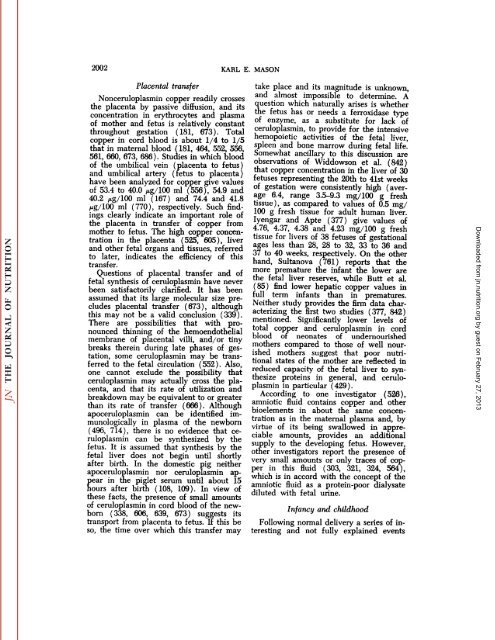conspectus of researchon copper metabolism and requirements
conspectus of researchon copper metabolism and requirements
conspectus of researchon copper metabolism and requirements
Create successful ePaper yourself
Turn your PDF publications into a flip-book with our unique Google optimized e-Paper software.
2002 KARL E. MASON<br />
Placental transfer<br />
Nonceruloplasmin <strong>copper</strong> readily crosses<br />
the placenta by passive diffusion, <strong>and</strong> its<br />
concentration in erythrocytes <strong>and</strong> plasma<br />
<strong>of</strong> mother <strong>and</strong> fetus is relatively constant<br />
throughout gestation (181, 673). Total<br />
<strong>copper</strong> in cord blood is about 1/4 to 1/5<br />
that in maternal blood (181, 464, 552, 556,<br />
561, 660, 673, 686). Studies in which blood<br />
<strong>of</strong> the umbilical vein (placenta to fetus)<br />
<strong>and</strong> umbilical artery (fetus to placenta)<br />
have been analyzed for <strong>copper</strong> give values<br />
<strong>of</strong> 53.4 to 40.0 fig/100 ml (556), 54.9 <strong>and</strong><br />
40.2 Mg/100 ml (167) <strong>and</strong> 74.4 <strong>and</strong> 41.8<br />
/ig/100 ml (770), respectively. Such find<br />
ings clearly indicate an important role <strong>of</strong><br />
the placenta in transfer <strong>of</strong> <strong>copper</strong> from<br />
mother to fetus. The high <strong>copper</strong> concen<br />
tration in the placenta (525, 605), liver<br />
<strong>and</strong> other fetal organs <strong>and</strong> tissues, referred<br />
to later, indicates the efficiency <strong>of</strong> this<br />
transfer.<br />
Questions <strong>of</strong> placental transfer <strong>and</strong> <strong>of</strong><br />
fetal synthesis <strong>of</strong> ceruloplasmin have never<br />
been satisfactorily clarified. It has been<br />
assumed that its large molecular size pre<br />
cludes placental transfer (673), although<br />
this may not be a valid conclusion (339).<br />
There are possibilities that with pro<br />
nounced thinning <strong>of</strong> the hemoendothelial<br />
membrane <strong>of</strong> placental villi, <strong>and</strong>/or tiny<br />
breaks therein during late phases <strong>of</strong> ges<br />
tation, some ceruloplasmin may be trans<br />
ferred to the fetal circulation (552). Also,<br />
one cannot exclude the possibility that<br />
ceruloplasmin may actually cross the pla<br />
centa, <strong>and</strong> that its rate <strong>of</strong> utilization <strong>and</strong><br />
breakdown may be equivalent to or greater<br />
than its rate <strong>of</strong> transfer (666). Although<br />
apoceruloplasmin can be identified immunologically<br />
in plasma <strong>of</strong> the newborn<br />
(496, 714), there is no evidence that ce<br />
ruloplasmin can be synthesized by the<br />
fetus. It is assumed that synthesis by the<br />
fetal liver does not begin until shortly<br />
after birth. In the domestic pig neither<br />
apoceruloplasmin nor ceruloplasmin ap<br />
pear in die piglet serum until about 15<br />
hours after birth (108, 109). In view <strong>of</strong><br />
these facts, the presence <strong>of</strong> small amounts<br />
<strong>of</strong> ceruloplasmin in cord blood <strong>of</strong> the new<br />
born (338, 606, 639, 673) suggests its<br />
transport from placenta to fetus. If this be<br />
so, the time over which this transfer may<br />
take place <strong>and</strong> its magnitude is unknown,<br />
<strong>and</strong> almost impossible to determine. A<br />
question which naturally arises is whether<br />
the fetus has or needs a ferroxidase type<br />
<strong>of</strong> enzyme, as a substitute for lack <strong>of</strong><br />
ceruloplasmin, to provide for the intensive<br />
hemopoietic activities <strong>of</strong> the fetal liver,<br />
spleen <strong>and</strong> bone marrow during fetal life.<br />
Somewhat ancillary to this discussion are<br />
observations <strong>of</strong> Widdowson et al. (842)<br />
that <strong>copper</strong> concentration in the liver <strong>of</strong> 30<br />
fetuses representing the 20th to 41st weeks<br />
<strong>of</strong> gestation were consistently high (aver<br />
age 6.4, range 3.5-9.3 mg/100 g fresh<br />
tissue), as compared to values <strong>of</strong> 0.5 mg/<br />
100 g fresh tissue for adult human liver,<br />
lyengar <strong>and</strong> Apte (377) give values <strong>of</strong><br />
4.76, 4.37, 4.38 <strong>and</strong> 4.23 mg/100 g fresh<br />
tissue for livers <strong>of</strong> 38 fetuses <strong>of</strong> gestational<br />
ages less than 28, 28 to 32, 33 to 36 <strong>and</strong><br />
37 to 40 weeks, respectively. On the other<br />
h<strong>and</strong>, Sultanova (761) reports that the<br />
more premature the infant the lower are<br />
the fetal liver reserves, while Butt et al.<br />
(85) find lower hepatic <strong>copper</strong> values in<br />
full term infants than in prematures.<br />
Neither study provides the firm data char<br />
acterizing the first two studies (377, 842)<br />
mentioned. Significantly lower levels <strong>of</strong><br />
total <strong>copper</strong> <strong>and</strong> ceruloplasmin in cord<br />
blood <strong>of</strong> neonates <strong>of</strong> undernourished<br />
mothers compared to those <strong>of</strong> well nour<br />
ished mothers suggest that poor nutri<br />
tional states <strong>of</strong> the mother are reflected in<br />
reduced capacity <strong>of</strong> the fetal liver to syn<br />
thesize proteins in general, <strong>and</strong> cerulo<br />
plasmin in particular (429).<br />
According to one investigator (526),<br />
amniotic fluid contains <strong>copper</strong> <strong>and</strong> other<br />
bioelements in about the same concen<br />
tration as in the maternal plasma <strong>and</strong>, by<br />
virtue <strong>of</strong> its being swallowed in appre<br />
ciable amounts, provides an additional<br />
supply to the developing fetus. However,<br />
other investigators report the presence <strong>of</strong><br />
very small amounts or only traces <strong>of</strong> cop<br />
per in this fluid (303, 321, 324, 564),<br />
which is in accord with the concept <strong>of</strong> the<br />
amniotic fluid as a protein-poor dialysate<br />
diluted with fetal urine.<br />
Infanctj <strong>and</strong> childhood<br />
Following normal delivery a series <strong>of</strong> in<br />
teresting <strong>and</strong> not fully explained events<br />
Downloaded from<br />
jn.nutrition.org<br />
by guest on February 27, 2013
















